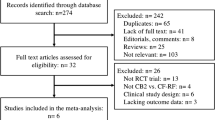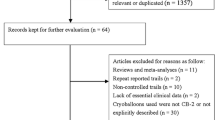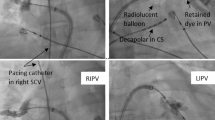Abstract
Objectives
It is imperative to understand the influence of second-generation cryoballoon (CB-2) and contact-force sensing radiofrequency ablation (CF-RF) on clinical outcomes in atrial fibrillation (AF). This updated meta-analysis of randomized controlled trials (RCTs) examined the efficacy and safety of CB-2 vs. CF-RF in patients with AF.
Methods
RCTs on the use of CB-2 vs. CF-RF in patients with AF were included. The primary outcome was the recurrence of AF, and the key secondary outcomes included serious complications, acute pulmonary vein isolation (PVI), procedure duration, and fluoroscopy time.
Results
A total of 261 articles were identified, and five studies with a total of 845 participants were included in the study. A total of 93% of participants had paroxysmal AF, 7% of participants had persistent AF, and none of participants had permanent AF. There were 499 participants in the CB-2 arm and 346 in the CF-RF arm. AF recurrence was comparable in the CB-2 group (30.3%) and the CF-RF group (29.2%) (OR = 0.93; 95%CI = 0.56–1.54; P = 0.79; I2 = 48%). There were no statistical differences in acute PVI (P = 0.92; I2 = 0%) and serious complications (P = 0.87; I2 = 47%) between the two groups. The procedure duration was shorter in the CB-2 group than in the CF-RF group (MD = − 13.39; 95%CI = − 15.58, − 7.19; P < 0.0001; I2 = 59%).
Conclusion
Our study demonstrated that CB-2 and CF-RF had comparable recurrences of AF and similar incidences of serious complications in AF patients during the ablation process.




Similar content being viewed by others
Data availability
The datasets used and/or analyzed during the current study are available from the corresponding author on reasonable request.
References
Roy D. Rationale and design of a study assessing treatment strategies of atrial fibrillation in patients with heart failure: the Atrial Fibrillation and Congestive Heart Failure (AF-CHF) trial. Am Heart J. 2002;144(4):597–607.
Kirchhof P, Benussi S, Kotecha D, Ahlsson A, Atar D, Casadei B, et al. 2016 ESC Guidelines for the management of atrial fibrillation developed in collaboration with EACTS. Rev Esp Cardiol. 2017;70(1):50. https://doi.org/10.1016/j.rec.2016.11.033.
Calkins H, Kuck KH, Cappato R, Brugada J, Camm AJ, Chen SA, et al. 2012 HRS/EHRA/ECAS expert consensus statement on catheter and surgical ablation of atrial fibrillation: recommendations for patient selection, procedural techniques, patient management and follow-up, definitions, endpoints, and research trial design. Europace. 2012;14(4):528–606. https://doi.org/10.1093/europace/eus027.
Hakalahti A, Biancari F, Nielsen JC, Raatikainen MJ. Radiofrequency ablation vs. antiarrhythmic drug therapy as first line treatment of symptomatic atrial fibrillation: systematic review and meta-analysis. Europace. 2015;17(3):370–8. https://doi.org/10.1093/europace/euu376.
Mulder BA, Al-Jazairi MIH, Arends BKO, Bax N, Dijkshoorn LA, Sheikh U, et al. Pulmonary vein anatomy addressed by computed tomography and relation to success of second-generation cryoballoon ablation in paroxysmal atrial fibrillation. Clin Cardiol. 2019;42(4):438–43. https://doi.org/10.1002/clc.23163.
Bhatty S, Saliaris AP. Atrial fibrillation ablation in the era of cryoballoon and force-sensing catheters: freeze or burn? Curr Treat Options Cardiovasc Med. 2015;17(4):374. https://doi.org/10.1007/s11936-015-0374-1.
Zhou X, Lv W, Zhang W, Ye Y, Li Y, Zhou Q, et al. Comparative efficacy and safety of contact force-sensing catheter and second-generation cryoballoon ablation for atrial fibrillation: a meta-analysis. Braz J Med Biol Res. 2017;50(9):e6409. https://doi.org/10.1590/1414-431X20176409.
Kuck KH, Brugada J, Furnkranz A, Metzner A, Ouyang F, Chun KR, et al. Cryoballoon or radiofrequency ablation for paroxysmal atrial fibrillation. N Engl J Med. 2016;374(23):2235–45. https://doi.org/10.1056/NEJMoa1602014.
Kuck KH, Furnkranz A, Chun KR, Metzner A, Ouyang F, Schluter M, et al. Cryoballoon or radiofrequency ablation for symptomatic paroxysmal atrial fibrillation: reintervention, rehospitalization, and quality-of-life outcomes in the FIRE AND ICE trial. Eur Heart J. 2016;37(38):2858–65. https://doi.org/10.1093/eurheartj/ehw285.
Luik A, Radzewitz A, Kieser M, Walter M, Bramlage P, Hormann P, et al. Cryoballoon versus open irrigated radiofrequency ablation in patients with paroxysmal atrial fibrillation: the prospective, randomized, controlled, Noninferiority FreezeAF Study. Circulation. 2015;132(14):1311–9. https://doi.org/10.1161/CIRCULATIONAHA.115.016871.
Kuck KH, Brugada J, Schluter M, Braegelmann KM, Kueffer FJ, Chun KRJ, et al. The FIRE AND ICE Trial: what we know, what we can still learn, and what we need to address in the future. J Am Heart Assoc. 2018;7(24):e010777. https://doi.org/10.1161/JAHA.118.010777.
Buist TJ, Adiyaman A, Smit JJJ, Ramdat Misier AR, Elvan A. Arrhythmia-free survival and pulmonary vein reconnection patterns after second-generation cryoballoon and contact-force radiofrequency pulmonary vein isolation. Clin Res Cardiol. 2018;107(6):498–506. https://doi.org/10.1007/s00392-018-1211-9.
Giannopoulos G, Kossyvakis C, Vrachatis D, Aggeli C, Tsitsinakis G, Letsas K, et al. Effect of cryoballoon and radiofrequency ablation for pulmonary vein isolation on left atrial function in patients with nonvalvular paroxysmal atrial fibrillation: a prospective randomized study (Cryo-LAEF study). J Cardiovasc Electrophysiol. 2019;30(7):991–8. https://doi.org/10.1111/jce.13933.
Squara F, Zhao A, Marijon E, Latcu DG, Providencia R, Di Giovanni G, et al. Comparison between radiofrequency with contact force-sensing and second-generation cryoballoon for paroxysmal atrial fibrillation catheter ablation: a multicentre European evaluation. Europace. 2015;17(5):718–24. https://doi.org/10.1093/europace/euv060.
Propadalo I, Tranfic M, Vuka I, Barcot O, Pericic TP, Puljak L. In Cochrane reviews, risk of bias assessments for allocation concealment were frequently not in line with Cochrane’s Handbook guidance. J Clin Epidemiol. 2019;106:10–7. https://doi.org/10.1016/j.jclinepi.2018.10.002.
Wan X, Wang W, Liu J, Tong T. Estimating the sample mean and standard deviation from the sample size, median, range and/or interquartile range. BMC Med Res Methodol. 2014;14:135. https://doi.org/10.1186/1471-2288-14-135.
Andrade JG, Champagne J, Dubuc M, Deyell MW, Verma A, Macle L, et al. Cryoballoon or radiofrequency ablation for atrial fibrillation assessed by continuous monitoring: a randomized clinical trial. Circulation. 2019;140(22):1779–88. https://doi.org/10.1161/CIRCULATIONAHA.119.042622.
Gunawardene MA, Hoffmann BA, Schaeffer B, Chung DU, Moser J, Akbulak RO, et al. Influence of energy source on early atrial fibrillation recurrences: a comparison of cryoballoon vs. radiofrequency current energy ablation with the endpoint of unexcitability in pulmonary vein isolation. Europace. 2018;20(1):43–9. https://doi.org/10.1093/europace/euw307.
Watanabe R, Sairaku A, Yoshida Y, Nanasato M, Kamiya H, Suzuki H, et al. Head-to-head comparison of acute and chronic pulmonary vein stenosis for cryoballoon versus radiofrequency ablation. Pacing Clin Electrophysiol : PACE. 2018;41(4):376–82. https://doi.org/10.1111/pace.13293.
Murray MI, Arnold A, Younis M, Varghese S, Zeiher AM. Cryoballoon versus radiofrequency ablation for paroxysmal atrial fibrillation: a meta-analysis of randomized controlled trials. Clin Res Cardiol. 2018;107(8):658–69. https://doi.org/10.1007/s00392-018-1232-4.
Zhao A, Squara F, Marijon E, Thomas O. Two-year clinical outcome after a single cryoballoon ablation procedure: a comparison of first- and second-generation cryoballoons. Arch Cardiovasc Dis. 2017;110(10):543–9. https://doi.org/10.1016/j.acvd.2017.01.015.
Kajiyama T, Miyazaki S, Matsuda J, Watanabe T, Niida T, Takagi T, et al. Anatomic parameters predicting procedural difficulty and balloon temperature predicting successful applications in individual pulmonary veins during 28-mm second-generation cryoballoon ablation. JACC Clin Electrophysiol. 2017;3(6):580–8. https://doi.org/10.1016/j.jacep.2017.01.004.
Matta M, Anselmino M, Ferraris F, Scaglione M, Gaita F. Cryoballoon vs. radiofrequency contact force ablation for paroxysmal atrial fibrillation: a propensity score analysis. J Cardiovasc Med. 2018;19(4):141–7. https://doi.org/10.2459/JCM.0000000000000633.
Yokokawa M, Chugh A, Latchamsetty R, Ghanbari H, Crawford T, Jongnarangsin K, et al. Ablation of paroxysmal atrial fibrillation using a second-generation cryoballoon catheter or contact-force sensing radiofrequency ablation catheter: a comparison of costs and long-term clinical outcomes. J Cardiovasc Electrophysiol. 2018;29(2):284–90. https://doi.org/10.1111/jce.13378.
Chen CF, Gao XF, Duan X, Chen B, Liu XH, Xu YZ. Comparison of catheter ablation for paroxysmal atrial fibrillation between cryoballoon and radiofrequency: a meta-analysis. J Interv Card Electrophysiol. 2017;48(3):351–66. https://doi.org/10.1007/s10840-016-0220-8.
Jourda F, Providencia R, Marijon E, Bouzeman A, Hireche H, Khoueiry Z, et al. Contact-force guided radiofrequency vs. second-generation balloon cryotherapy for pulmonary vein isolation in patients with paroxysmal atrial fibrillation-a prospective evaluation. Europace. 2015;17(2):225–31. https://doi.org/10.1093/europace/euu215.
Koller ML, Schumacher B. Cryoballoon ablation of paroxysmal atrial fibrillation: bigger is better and simpler is better. Eur Heart J. 2009;30(6):636–7. https://doi.org/10.1093/eurheartj/ehp031.
Defaye P, Kane A, Jacon P, Mondesert B. Cryoballoon for pulmonary vein isolation: is it better tolerated than radiofrequency? Retrospective study comparing the use of analgesia and sedation in both ablation techniques. Arch Cardiovasc Dis. 2010;103(6–7):388–93. https://doi.org/10.1016/j.acvd.2010.06.004.
Nct. Changes in cardiac autonomic nervous system following atrial fibrillation ablation. https://clinicaltrialsgov/show/NCT03811639 2019.
Funding
This study was sponsored by the Natural Science Foundation of Shandong Province of China (ZR2019PH036) and the Key Research and Development Plan of Jinan Shandong Province of China (201805056).
Author information
Authors and Affiliations
Corresponding author
Ethics declarations
Conflict of interest
The authors declare that they have no conflict of interest.
Additional information
Publisher’s note
Springer Nature remains neutral with regard to jurisdictional claims in published maps and institutional affiliations.
Wei Wang is the co-first author
Electronic supplementary material
ESM 1
(DOCX 14 kb)
Rights and permissions
About this article
Cite this article
Wang, Y., Wang, W., Yao, J. et al. Second-generation cryoballoon vs. contact-force sensing radiofrequency catheter ablation in atrial fibrillation: a meta-analysis of randomized controlled trials. J Interv Card Electrophysiol 60, 9–19 (2021). https://doi.org/10.1007/s10840-020-00893-w
Received:
Accepted:
Published:
Issue Date:
DOI: https://doi.org/10.1007/s10840-020-00893-w




